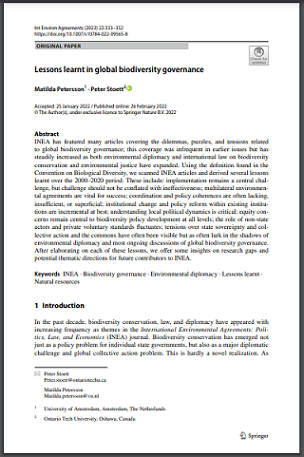
INEA has featured many articles covering the dilemmas, puzzles, and tensions related to global biodiversity governance; this coverage was infrequent in earlier issues but has steadily increased as both environmental diplomacy and international law on biodiversity conservation and environmental justice have expanded. Using the defnition found in the Convention on Biological Diversity, we scanned INEA articles and derived several lessons learnt over the 2000–2020 period. These include: implementation remains a central challenge, but challenge should not be confated with inefectiveness; multilateral environmental agreements are vital for success; coordination and policy coherences are often lacking, insufcient, or superfcial; institutional change and policy reform within existing institutions are incremental at best; understanding local political dynamics is critical; equity concerns remain central to biodiversity policy development at all levels; the role of non-state actors and private voluntary standards fuctuates; tensions over state sovereignty and collective action and the commons have often been visible but as often lurk in the shadows of environmental diplomacy and most ongoing discussions of global biodiversity governance. After elaborating on each of these lessons, we ofer some insights on research gaps and potential thematic directions for future contributors to INEA.














